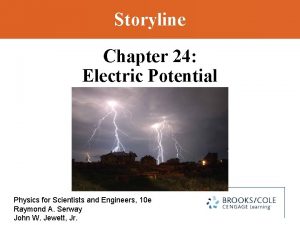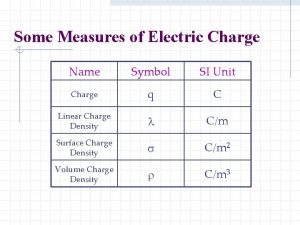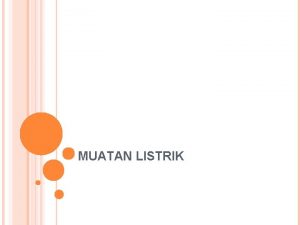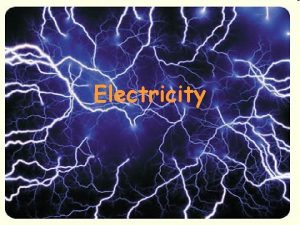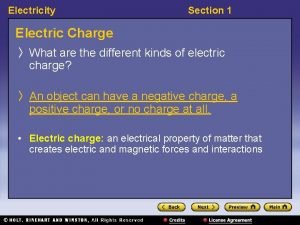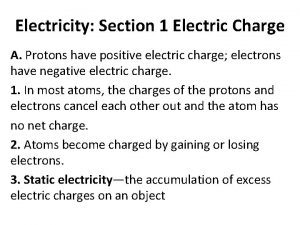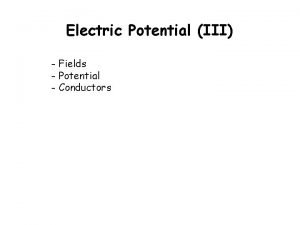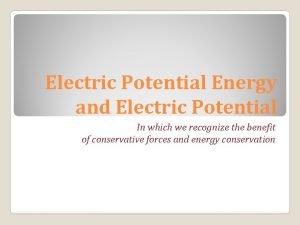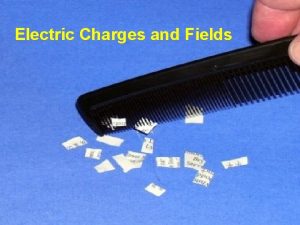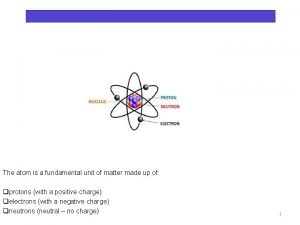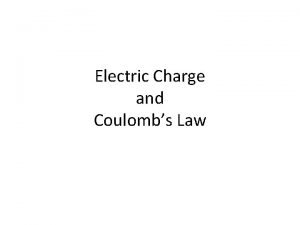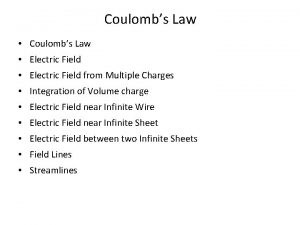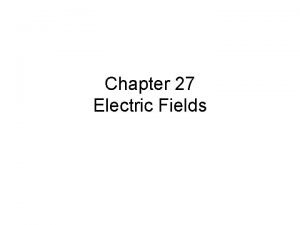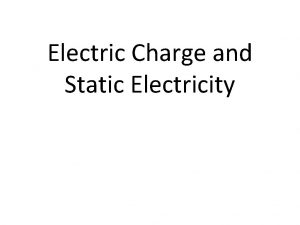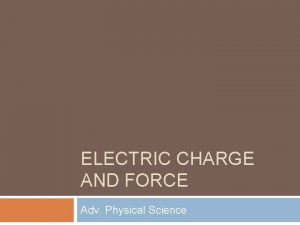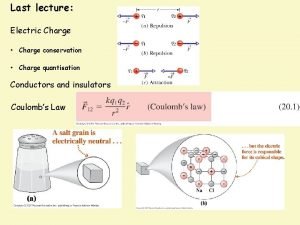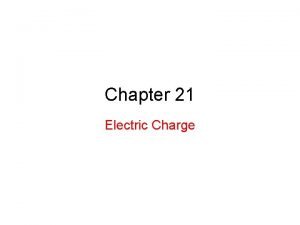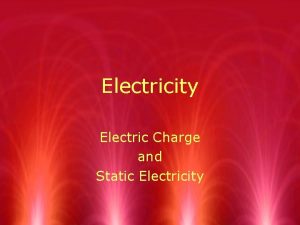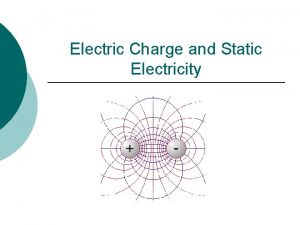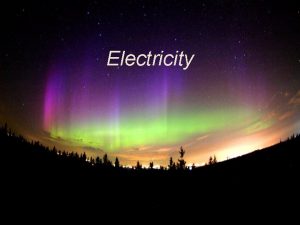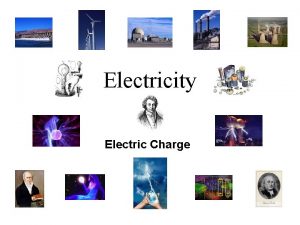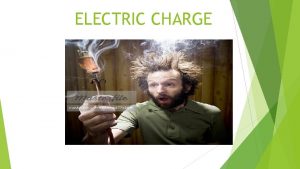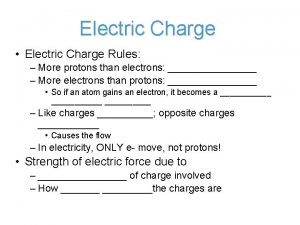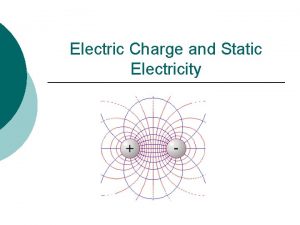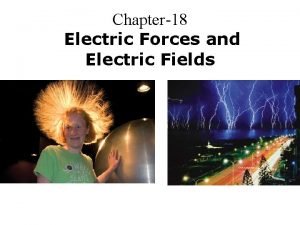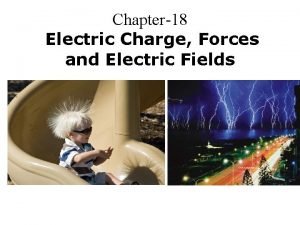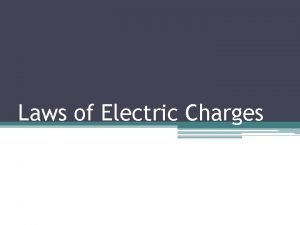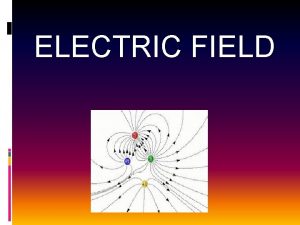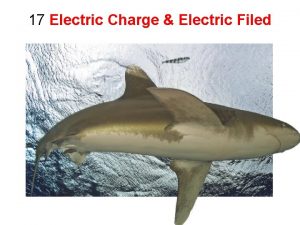Physical Science 7 1 Electric Charge Electric Charge
























- Slides: 24

Physical Science 7. 1 Electric Charge

Electric Charge 7. 1 Positive and Negative Charge • Atoms contain particles called protons, neutrons, and electrons. • Protons and electrons have electric charge, and neutrons have no electric charge.

Electric Charge 7. 1 Positive and Negative Charge • Protons have positive electric charge and electrons have negative electric charge. • The amount of positive charge on a proton equals the amount of negative charge on an electron.

Electric Charge 7. 1 Positive and Negative Charge • An atom contains equal numbers of protons and electrons, so the positive and negative charges cancel out and an atom has no net electric charge. • Objects with no net charge are said to be electrically neutral.

Electric Charge 7. 1 Transferring Charge • Compared to the electrons in carpet atoms, electrons are bound more tightly to the atoms in the soles of your shoes. • When you walk on the carpet, electrons are transferred from the carpet to the soles of your shoes.

Electric Charge 7. 1 Transferring Charge • The soles of your shoes have an excess of electrons and become negatively charged. • The carpet has lost electrons and has an excess of positive charge. • The accumulation of excess electric charge on an object is called static electricity.

Electric Charge 7. 1 Conservation of Charge • According to the law of conservation of charge, charge can be transferred from object to object, but it cannot be created or destroyed. • Whenever an object becomes charged, electric charges have moved from one place to another.

Electric Charge 7. 1 Charges Exert Forces • Unlike charges attract each other, and like charges repel each other. • The force between electric charges also Opposite charges attract depends on the distance between Like charges repel charges. The force decreases as the charges get farther apart.

Electric Charge 7. 1 Electric Fields • An electric field surrounds every electric charge and exerts the force that causes other electric charges to be attracted or repelled. • Any charge that is placed in an electric field will be pushed or pulled by the field.

Electric Charge 7. 1 Conductors and Insulators • If you reach for a metal doorknob after walking across a carpet, you might see a spark. • The spark is caused by electrons moving from your hand to the doorknob.

Electric Charge 7. 1 Conductors • A material in which electrons are able to move easily is a conductor. • The best electrical conductors are metals. • The atoms in metals have electrons that are able to move easily through the material.

Electric Charge 7. 1 Insulators • A material in which electrons are not able to move easily is an insulator. • Electrons are held tightly to atoms in insulators. • Most plastics are insulators. • The plastic coating around electric wires prevents a dangerous electric shock when you touch the wire.

Electric Charge 7. 1 Charging Objects • Rubbing two materials together can result in a transfer of electrons. • Then one material is left with a positive charge and the other with an equal amount of negative charge. • The process of transferring charge by touching or rubbing is called charging by contact.

Electric Charge 7. 1 Charging at a Distance • The balloon on the left is neutral. The balloon on the right is negatively charged. It produces a positively charged area on the sleeve by repelling electrons. • The rearrangement of electrons on a neutral object caused by a nearby charged object is called charging by induction.

Electric Charge 7. 1 Lightning • Lightning is a large static discharge. • A static discharge is a transfer of charge between two objects because of a buildup of static electricity. • A thundercloud is a mighty generator of static electricity. As air masses move and swirl in the cloud, areas of positive and negative charge build up.

Electric Charge 7. 1 Lightning • Eventually, enough charge builds up to cause a static discharge between the cloud and the ground. • As the electric charges move through the air, they collide with atoms and molecules. These collisions cause the atoms and molecules in air to emit light.

Electric Charge 7. 1 Thunder • Lightning also generates powerful sound waves. • The electrical energy in a lightning bolt rips electrons off atoms in the atmosphere and produces great amounts of heat. • The heat causes air in the bolt's path to expand rapidly, producing sound waves that you hear as thunder.

Electric Charge 7. 1 Grounding • Any object connected to Earth by a good conductor will transfer any excess electric charge to Earth. • Connecting an object to Earth with a conductor is called grounding.

Section Check 7. 1 Question 1 The law of conservation of charge states that ______.

Section Check 7. 1 Answer Charge can be transferred from object to object, but it cannot be created or destroyed.

Section Check 7. 1 Question 2 Which of the following is the best conductor of electricity? A. copper B. rubber C. wood D. water

Section Check 7. 1 Answer The answer is A. The best electrical conductors are metals.

Section Check 7. 1 Question 3 The accumulation of excess electric charge on an object is called _____. A. lightning B. static electricity C. static discharge D. thunder

Section Check 7. 1 Answer The answer is B. Lightning is a large static discharge that emits light.
 Difference between charge and electric charge
Difference between charge and electric charge Difference between charge and electric charge
Difference between charge and electric charge Chapter 21 electric charge and electric field
Chapter 21 electric charge and electric field Chapter 21 electric charge and electric field
Chapter 21 electric charge and electric field Units of charge
Units of charge Units of a charge
Units of a charge 3 branches of science
3 branches of science Natural and physical science
Natural and physical science What is her favourite subject
What is her favourite subject Electric field of a finite line charge
Electric field of a finite line charge Electric field symbol
Electric field symbol What is electric charge measured in
What is electric charge measured in Electrostatics equations
Electrostatics equations Section 1 electric charge crossword puzzle answers
Section 1 electric charge crossword puzzle answers Section 1 electric charge crossword puzzle answers
Section 1 electric charge crossword puzzle answers Section 1 electric charge
Section 1 electric charge Electric field of a finite line charge
Electric field of a finite line charge The electric potential energy of a charge is zero at point
The electric potential energy of a charge is zero at point Rubbing amber
Rubbing amber Charge of proton
Charge of proton Unit of charge
Unit of charge Electric field for infinite line charge
Electric field for infinite line charge Chapter 6 section 1 electric charge worksheet answers
Chapter 6 section 1 electric charge worksheet answers Formula of electric field
Formula of electric field Chapter 17 section 1 electric charge and force answer key
Chapter 17 section 1 electric charge and force answer key









